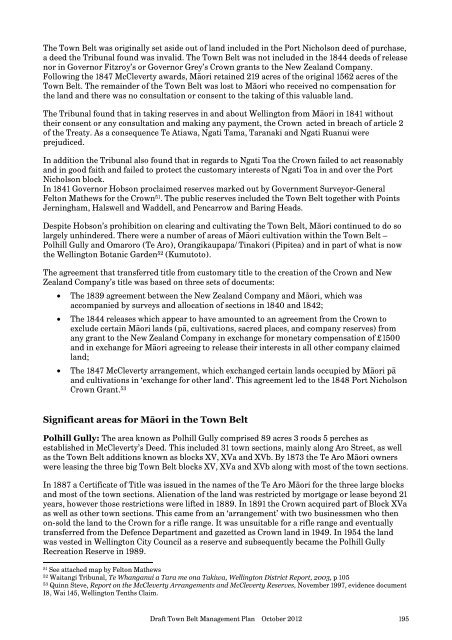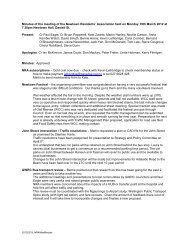Draft Town Belt Management Plan - Wellington City Council
Draft Town Belt Management Plan - Wellington City Council
Draft Town Belt Management Plan - Wellington City Council
Create successful ePaper yourself
Turn your PDF publications into a flip-book with our unique Google optimized e-Paper software.
The <strong>Town</strong> <strong>Belt</strong> was originally set aside out of land included in the Port Nicholson deed of purchase,<br />
a deed the Tribunal found was invalid. The <strong>Town</strong> <strong>Belt</strong> was not included in the 1844 deeds of release<br />
nor in Governor Fitzroy’s or Governor Grey’s Crown grants to the New Zealand Company.<br />
Following the 1847 McCleverty awards, Māori retained 219 acres of the original 1562 acres of the<br />
<strong>Town</strong> <strong>Belt</strong>. The remainder of the <strong>Town</strong> <strong>Belt</strong> was lost to Māori who received no compensation for<br />
the land and there was no consultation or consent to the taking of this valuable land.<br />
The Tribunal found that in taking reserves in and about <strong>Wellington</strong> from Māori in 1841 without<br />
their consent or any consultation and making any payment, the Crown acted in breach of article 2<br />
of the Treaty. As a consequence Te Atiawa, Ngati Tama, Taranaki and Ngati Ruanui were<br />
prejudiced.<br />
In addition the Tribunal also found that in regards to Ngati Toa the Crown failed to act reasonably<br />
and in good faith and failed to protect the customary interests of Ngati Toa in and over the Port<br />
Nicholson block.<br />
In 1841 Governor Hobson proclaimed reserves marked out by Government Surveyor-General<br />
Felton Mathews for the Crown 51 . The public reserves included the <strong>Town</strong> <strong>Belt</strong> together with Points<br />
Jerningham, Halswell and Waddell, and Pencarrow and Baring Heads.<br />
Despite Hobson’s prohibition on clearing and cultivating the <strong>Town</strong> <strong>Belt</strong>, Māori continued to do so<br />
largely unhindered. There were a number of areas of Māori cultivation within the <strong>Town</strong> <strong>Belt</strong> –<br />
Polhill Gully and Omaroro (Te Aro), Orangikaupapa/Tinakori (Pipitea) and in part of what is now<br />
the <strong>Wellington</strong> Botanic Garden 52 (Kumutoto).<br />
The agreement that transferred title from customary title to the creation of the Crown and New<br />
Zealand Company’s title was based on three sets of documents:<br />
• The 1839 agreement between the New Zealand Company and Māori, which was<br />
accompanied by surveys and allocation of sections in 1840 and 1842;<br />
• The 1844 releases which appear to have amounted to an agreement from the Crown to<br />
exclude certain Māori lands (pā, cultivations, sacred places, and company reserves) from<br />
any grant to the New Zealand Company in exchange for monetary compensation of £1500<br />
and in exchange for Māori agreeing to release their interests in all other company claimed<br />
land;<br />
• The 1847 McCleverty arrangement, which exchanged certain lands occupied by Māori pā<br />
and cultivations in ‘exchange for other land’. This agreement led to the 1848 Port Nicholson<br />
Crown Grant. 53<br />
Significant areas for Māori in the <strong>Town</strong> <strong>Belt</strong><br />
Polhill Gully: The area known as Polhill Gully comprised 89 acres 3 roods 5 perches as<br />
established in McCleverty’s Deed. This included 31 town sections, mainly along Aro Street, as well<br />
as the <strong>Town</strong> <strong>Belt</strong> additions known as blocks XV, XVa and XVb. By 1873 the Te Aro Māori owners<br />
were leasing the three big <strong>Town</strong> <strong>Belt</strong> blocks XV, XVa and XVb along with most of the town sections.<br />
In 1887 a Certificate of Title was issued in the names of the Te Aro Māori for the three large blocks<br />
and most of the town sections. Alienation of the land was restricted by mortgage or lease beyond 21<br />
years, however those restrictions were lifted in 1889. In 1891 the Crown acquired part of Block XVa<br />
as well as other town sections. This came from an ‘arrangement’ with two businessmen who then<br />
on-sold the land to the Crown for a rifle range. It was unsuitable for a rifle range and eventually<br />
transferred from the Defence Department and gazetted as Crown land in 1949. In 1954 the land<br />
was vested in <strong>Wellington</strong> <strong>City</strong> <strong>Council</strong> as a reserve and subsequently became the Polhill Gully<br />
Recreation Reserve in 1989.<br />
51 See attached map by Felton Mathews<br />
52 Waitangi Tribunal, Te Whanganui a Tara me ona Takiwa, <strong>Wellington</strong> District Report, 2003, p 105<br />
53 Quinn Steve, Report on the McCleverty Arrangements and McCleverty Reserves, November 1997, evidence document<br />
I8, Wai 145, <strong>Wellington</strong> Tenths Claim.<br />
<strong>Draft</strong> <strong>Town</strong> <strong>Belt</strong> <strong>Management</strong> <strong>Plan</strong> October 2012 195





